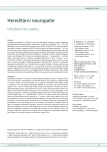-
Medical journals
- Career
Early Experience with Intraoperative MRI Scanning during Pituitary Adenoma Resection
Authors: D. Netuka 1; V. Masopust 1; T. Belšan 2; F. Kramář 1; V. Beneš 1
Authors‘ workplace: Neurochirurgická klinika 1. LF UK a IPVZ, ÚVN Praha 1; Radiologické oddělení ÚVN Praha 2
Published in: Cesk Slov Neurol N 2009; 72/105(1): 45-50
Category: Short Communication
Overview
A multifunctional surgical suite with intraoperative MRI (iMRI) has been in use since April 2008 in the Central Military Hospital, Prague. The authors of the article assess the safety, the quality and the effect of iMRI on the extent of resection. 18 endoscopic endonasal procedures in 16 patients with pituitary adenoma were performed from April 18, 2008 to May 16, 2008. Radical resection was the objective of surgery in 8 cases, and partial resection in 8 cases. No safety issues were recorded. iMRI was always in a good quality. Radical resection was confirmed by iMRI in 6 cases (75%) in the group of patients indicated for radical resection. In two cases, a residuum was disclosed by iMRI. The residuum was resected after iMRI scanning. Further resection after iMRI was performed in 4 cases (50%) in the group of patients indicated for partial resection. Based on iMRI findings, the procedure was classified as radical in one case. A small residuum was disclosed on a postoperative MRI. iMRI changed the extent of surgery in 6 cases (37.5%), and was wrongly interpreted by our team in one case (6.25%). iMRI was observed to have an effect on the extent of pituitary adenoma resection in this small series.
Key words:
pituitary adenoma – transsphenoidal surgery – intraoperative magnetic resonance imaging – extent of resection
Sources
1. Black PM, Moriarty T, Alexander E jr, Stieg P, Woodard EJ, Gleason PL et al. Development and implementation of intraoperative magnetic resonance imaging and its neurosurgical applications. Neurosurgery 1997; 41(4): 831–842.
2. Fahlbusch R, Ganslandt O, Buchfelder M, Schott W, Nimsky C. Intraoperative magnetic resonance imaging during transsphenoidal surgery. J Neurosurg 2001; 95(3): 381–390.
3. Steinmeier R, Fahlbusch R, Ganslandt O, Nimsky C, Buchfelder M, Kaus M et al. Intraoperative magnetic resonance imaging with the magnetom open scanner: concepts, neurosurgical indications, and procedures: a preliminary report. Neurosurgery 1998; 43(4): 739–747.
4. Hall WA, Liu H, Martin AJ, Pozza CH, Maxwell RE, Truwit CL. Safety, efficacy, and functionality of high-field strength interventional magnetic resonance imaging for neurosurgery. Neurosurgery 2000; 46(3): 632–641.
5. Sutherland GR, Kaibara T, Louw D, Hoult DI, Tomanek B, Saunders J. A mobile high field magnetic resonance system for neurosurgery. J Neurosurg 1999; 91(5): 804–813.
6. Jankovski A, Raftopoulos C, Vaz G, Hermoye L, Cosnard G, Francotte F et al. Intra-operative MR at 3T: short report. JBR-BTR 2007; 90(4): 249–251.
7. Masopust V, Netuka D, Beneš V. Endonazální endoskopická transsfenoidální resekce selárních lézí. Cesk Slov Neurol N 2008; 71/104(6): 704–710.
8. Ntoukas V, Krishnan R, Seifert V. The new generation polestar n20 for conventional neurosurgical operating rooms: a preliminary report. Neurosurgery 2008; 62 (Suppl 1): 82–89.
9. Martin CH, Schwartz R, Jolesz F, Black PM. Transsphenoidal resection of pituitary adenomas in an intraoperative MRI unit. Pituitary 1999; 2(2): 155–162.
10. Nimsky C, Ganslandt O, Von Keller B, Romstöck J,Fahlbusch R. Intraoperative high field-strength MR imaging: implementation and experience in 200 patients. Radiology 2004; 233(1): 67–78.
11. Fahlbusch R, Keller B, Ganslandt O, Kreutzer J, Nimsky C. Transsphenoidal surgery in acromegaly investigated by intraoperative high field magnetic resonance imaging. Eur J Endocrinol 2005; 153(2): 239–248.
12. Nimsky C, von Keller B, Ganslandt O, Fahlbusch R.Intraoperative high field magnetic resonance imaging in transsphenoidal surgery of hormonally inactive pituitary macroadenomas. Neurosurgery 2006; 59(1): 105–114.
13. Jones J, Ruge J. Intraoperative magnetic resonance imaging in pituitary macroadenoma surgery: an assessment of visual outcome. Neurosurg Focus 2007; 23(5): E12.
14. Schwartz TH, Stieg PE, Anand VK. Endoscopic transsphenoidal pituitary surgery with intraoperative magnetic resonance imaging. Neurosurgery 2006; 58 (1 Suppl): ONS44–ONS51.
15. Anand VK, Schwartz TH, Hiltzik DH, Kacker A. Endoscopic transphenoidal pituitary surgery with real-time intraoperative magnetic resonance imaging. Am J Rhinol 2006; 20(4): 401–405.
16. Bohinski RJ, Warnick RE, Gaskill-Shipley MF, Zuccarello M, van Loveren HR, Kormos DW, Tew JM jr. Intraoperative magnetic resonance imaging to determine the extent of resection of pituitary macroadenomas during transsphenoidal microsurgery. Neurosurgery 2001; 49(5): 1133–1143.
Labels
Paediatric neurology Neurosurgery Neurology
Article was published inCzech and Slovak Neurology and Neurosurgery

2009 Issue 1-
All articles in this issue
- Hereditary Neuropathy
-
Intraspinal Lumbar Synovial Cysts I.
Overview of the Topic - Differential Diagnosis of Neuroacanthocytosis
- Detection of Microembolisation with the Use of Transcranial Doppler Sonography
- The Use of Titan and PEEK Implants in Stand Alone ALIF Surgery for Degenerative Disease of the Lumbosacral Spine – a Prospective Study
- Early Experience with Intraoperative MRI Scanning during Pituitary Adenoma Resection
- Sclerosis Multiplex and Comorbidity with Another Autoimmune Disease
- Ependymal “Dot-Dash” Sign, a Typical Symptom in Patients with Multiple Sclerosis
- Intraspinal Lumbar Synovial Cysts II – Surgical Treatment of 13 Patients
- Dermatomyositis Associated with Multiple Myeloma and Amyloidosis – a Case Report
- Thrombotic Thrombocytopenic Purpura (TTP) in a Female Patient with Multiple Sclerosis – a Case Report
- Virtual Autopsy Performed by Magnetic Resonance Imaging – a Case Report
- Prediction of Clinical Course of Herpes Simplex Encephalitis from Magnetic Resonance Imaging – a Case Report
- Czech and Slovak Neurology and Neurosurgery
- Journal archive
- Current issue
- Online only
- About the journal
Most read in this issue- Hereditary Neuropathy
- Thrombotic Thrombocytopenic Purpura (TTP) in a Female Patient with Multiple Sclerosis – a Case Report
- Prediction of Clinical Course of Herpes Simplex Encephalitis from Magnetic Resonance Imaging – a Case Report
-
Intraspinal Lumbar Synovial Cysts I.
Overview of the Topic
Login#ADS_BOTTOM_SCRIPTS#Forgotten passwordEnter the email address that you registered with. We will send you instructions on how to set a new password.
- Career

